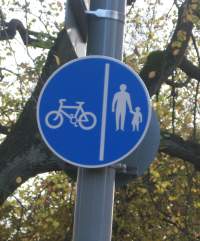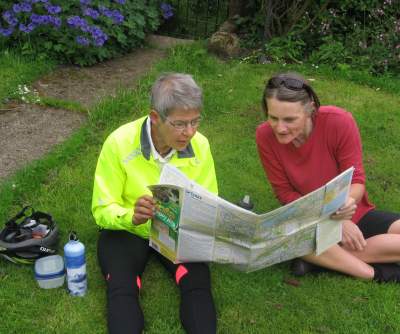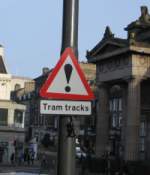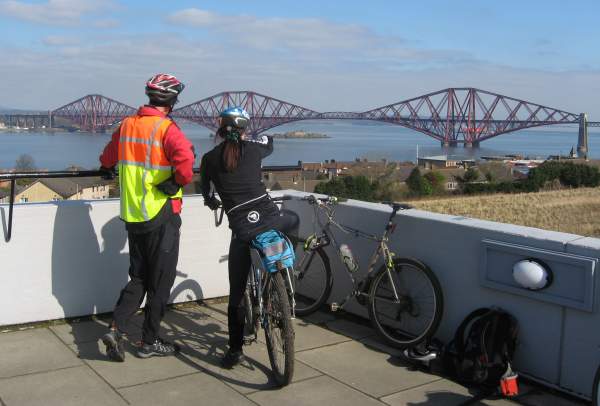Interested in riding a bike in the Scottish capital? This FAQ will give you the information you need to get started.
By Mike Lewis
First published: November 2016; updated: December 2024

By British standards, Edinbugh is very cycle-friendly. It has many off-road bike paths, on-road cycle lanes, forward stop lines at traffic lights, and other bike priority measures. And the city has lowered the speed limit on most of its roads.
But by the standards of cities in other northern European countries - notably the Netherlands, Germany and Denmark - Edinburgh falls far short. In some parts of town, cyclists are obliged to ride in heavy traffic. And while most motorists are aware of bike users and show them proper consideration, there is a sizeable minority who seem to resent the presence of cyclists and who behave accordingly.
Just about all of them. The only roads where cycling is banned are motorways and some main roads on the city's outskirts, including the City Bypass. In the town centre, part of the West Approach Road (between Canning Street and Gorgie) is also out of bounds. All other roads are open to cyclists.
But just because you can, it doesn't mean you'll want to. You'll probably prefer to avoid certain roads that carry particularly heavy traffic. There are usually good alternatives to these routes.
Yes. You can legally cycle in parks, on the canal towpath, and on the seafront esplanades and promenades, provided you do so responsibly and with consideration for other path users.

Signs like these indicate a
shared-use path or pavement
In most cases, no. Cycling on the pavement is illegal (for adults), and could result in a fine. (Note to American readers: in Britain, the term "pavement" refers to the sidewalk, not to the road itself.)
That said, there are some stretches of pavement in Edinburgh that are designated as "shared use": they can be used both by pedestrians and cyclists. They are clearly indicated by bike-plus-pedestrian signs, like the one in the photo.
The rules of the road for cyclists are pretty much the same as for other road users. You should ride on the same side of the road as motor traffic (that is, on the left), and observe the same rules and restrictions. That means stopping at red lights, not going the wrong way on one-way streets (except in a few cases where this is specifically allowed), and so forth. If you cycle at night, you must have lights: a white one at the front, red at the back.
Wearing a cycle helmet is generally considered a sensible thing to do, but it is not mandatory. Many - but by no means all - Edinburgh cyclists choose to do so.
Yes. There are several outlets where bikes can be hired by the day or week. For details, see this page.

A good cycling map can help you plan your route
If you browse the articles on this site, you'll find plenty of suggestions for pleasant rides, both within the city and in the nearby countryside. There are also some excellent cycling maps available for the area, in both paper and electronic formats. You can find more information about these - including details of where to buy or download them - on this page.
Another good way of getting ideas for rides is to peruse the blogs of local cycling groups, which often contain route descriptions and maps of their recent runs. See, for example, here and here.
You can't take bikes on most buses in the Edinburgh area. As an exception, you are allowed to take a folding bike on a bus, provided it is fully enclosed in a bag.
Bikes can be taken on Edinburgh's tram line, except at certain times and subject to a number of restrictions. See here for details.
Border Buses carry bikes on a few of their routes (at no extra charge); these connect Edinburgh with towns in the Scottish Borders. But not all buses on the relevant routes take bikes, and there is no way of knowing in advance which ones do (the information is not shown in their timetables or on their website). This makes it difficult to plan a day out.
Ember Buses, by contrast, carry bikes on all their services between Edinburgh and Dundee, and you can book a bike place in advance, although this is not always necessary. They have six to eight services per day in each direction, running via Ingliston (for Edinburgh Airport), Rosyth, Kinross and Perth. There is no extra charge for bikes.
You can usually also take your bike in a taxi. The so-called "black cabs" (the kind that you hail on the street; they are not necessarily black) are designed to carry wheelchairs, so they have no problem in accommodating bicycles. It is up to the driver whether they will actually take your bike, but most drivers will happily do so, provided the machine isn't dripping with mud. So-called "private hire cars" (the kind that must be booked in advance) are usually just ordinary cars; many of these are too small to carry bikes.
This question is complicated by the fact that several different train companies serve Edinburgh, and they have different policies and rules regarding bikes.
Most services within Scotland are run by ScotRail. On most of these services, you can take your bike free of charge and without any special formalities. Just wheel your bike onto the platform (don't ride it); when the train arrives, look for the door with a bike logo on it. But be aware that space for bikes is limited; if it is full, you will have to wait for the next train.
On ScotRail services from Edinburgh to Aberdeen and Inverness, you might need to book your bike in advance. You can do this when you buy your ticket.
Services between Edinburgh and England are run by LNER, Avanti West Coast, Cross Country, TransPennine Express and Caledonian Sleeper. These companies all carry bikes free of charge, but they vary in their policies regarding reservations. Some say that reservations are compulsory; others merely that they are recommended. It's best to check with the ticket office or the company's website before setting out. (Note that Lumo, which provides an alternative to LNER for services to Newcastle and London, does not carry bikes at all.)

Accidents involving cyclists and tram tracks are unfortunately all too frequent. Most of them are caused by bike wheels getting stuck in the tracks, or by cyclists slipping on tramlines in wet or icy weather. The usual advice is always to cross the tracks at as oblique an angle as possible, and to keep your speed down when doing so.
The most dangerous sections of the tram route are those in the city centre, with the Haymarket area being a particular black spot. It is less of an issue in the section between Haymarket and the airport, as the trams there mainly run on segregated tracks.
Fortunately, you can usually plan a route that avoids the tram tracks, even in the city centre. But if you do find yourself cycling on the tram route, and you are worried about the danger, the best policy is to dismount and wheel your bike.
If you leave your bike unlocked and unattended, you stand a good chance of it not being there when you get back. Edinburgh is not a high-crime city, but bike thefts are a fact of life here, just as in many other urban areas.
Make it a rule always to lock your machine whenever you leave it unattended - even for a few minutes. Use a good-quality lock, and secure the bike to a fixed object, preferably a proper bike rack. If possible, park it where there are a lot of people about, and be sure to remove any GPS units, cycle computers or other detachable devices.
Unfortunately, not that many Edinburgh hotels offer bike storage or secure parking. But there are exceptions, so check with the hotel when your make your booking. Hostels, on the other hand, tend to be more cycle-friendly.

The world-famous Forth Bridge
This is a hard one to answer. Scottish weather is notoriously uncertain, and it can vary hugely from day to day.
In general, summers are warm, but not often hot. With luck, there will be days when you will be cycling in T-shirt and shorts. But you're just as likely to need a sweater or a light wind-proof jacket. Summer daytime temperatures are typically around 16C to 20C (59F to 68F), and will go into the low to mid 20s (69F to 77F) during the occasional hot spell.
Similarly, winters are cold, but rarely freezing. We sometimes get cold snaps when the overnight temperature drops below zero, leaving icy patches on roads and paths the next day. But these don't usually last long. Typical winter daytime temperatures are 5C to 10C (41F to 50F). Except when we get snow - which isn't all that often - there's no reason why you can't enjoy a bike ride in the winter, provided you wrap up well.
Edinburgh is a lot drier than many other parts of Scotland, but if you're here for more than a few days, the chances are that you'll see some rain - at any time of the year. Strong winds are also common, especially in the winter, and these can make cycling unpleasant at times.
Finally, keep in mind that winter days are short: less than eight hours of daylight in December. But we make up for it in summer. In June and early July, you'll often be able to cycle in daylight up until about 10 pm.
Definitely. As you will see from this page, there are several active cycling groups here, and they all welcome visitors on their rides. Most of their rides are free, with no need to book in advance. But do try to choose a ride that matches your fitness level and abilities.
Browse all articles on this site
Cycling Edinburgh is maintained by Mike Lewis.
Contact me
Please contact me with your feedback, suggestions or details of events
you would like me to include on this site. You can email me at:
© Copyright Mike Lewis and contributors.